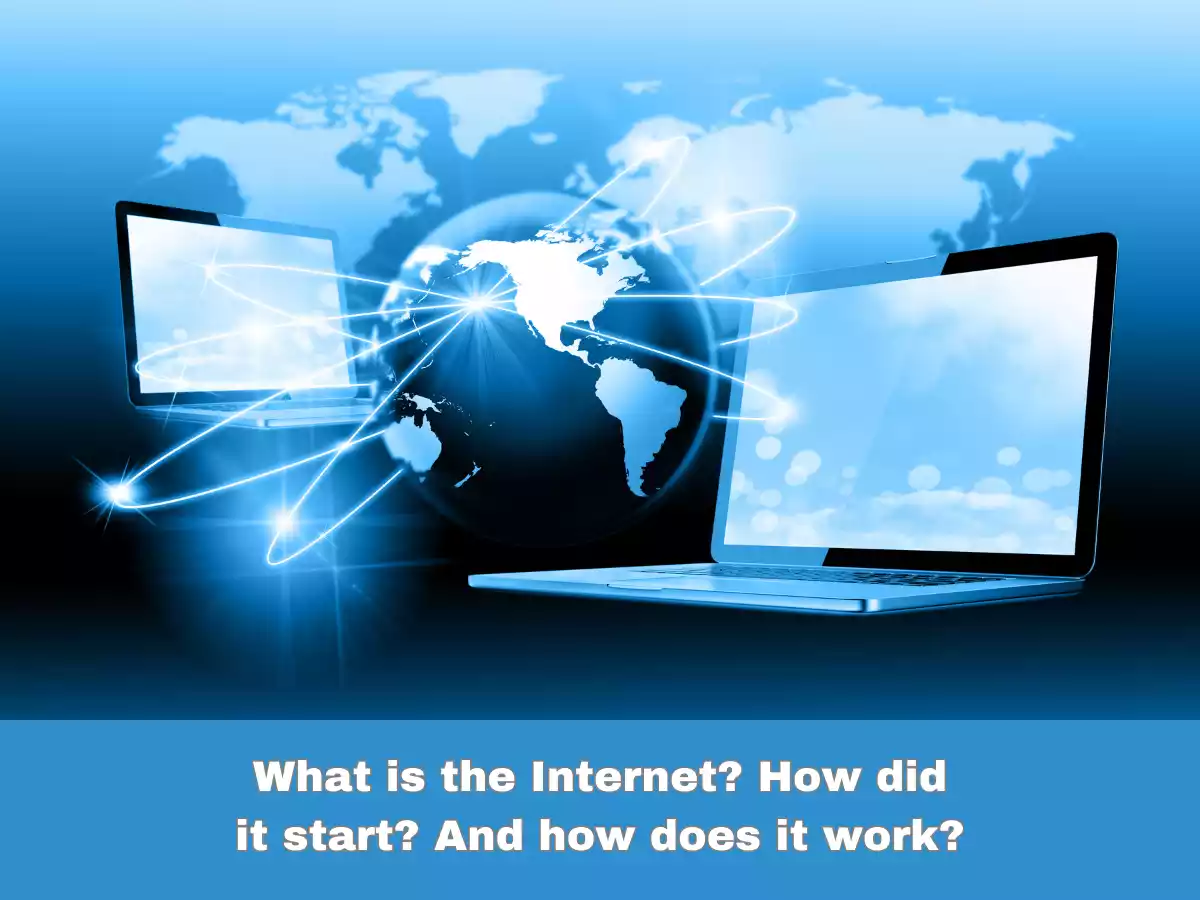The internet is an essential part of modern life, enabling us to connect with people all over the world, access information, and carry out a wide range of tasks online. However, despite its universal presence in our lives, many people are still unsure of what the internet actually is, how it started, and how it works. In this blog post, we will explore these questions in depth, providing a clear and concise overview of the internet and its history. By the end of this post, you will have a better understanding of the inner workings of this incredible technology and the role it plays in our lives today.
Table of Contents
ToggleDefinition of the internet
The internet is a global network of computers and other devices that are interconnected and communicate with each other using a standardized set of protocols. These protocols enable devices to exchange data and information across the network, allowing people all over the world to connect and communicate with each other. The internet is made up of millions of interconnected networks, including private, public, academic, and government networks, all working together to form a vast, decentralized network of information exchange. It has revolutionized the way we communicate, access information, and do business, and has become an integral part of modern society.
The difference between the internet and the World Wide Web
The terms “internet” and “World Wide Web” are often used interchangeably, but they actually refer to two different things. The internet is the global network of computers and other devices that are interconnected and communicate with each other using a standardized set of protocols. On the other hand, the World Wide Web (WWW or Web) is a system of interlinked hypertext documents and resources that are accessed over the internet.
In other words, the internet is the infrastructure that enables data and information to be exchanged across networks, while the World Wide Web is a collection of websites and web pages that are hosted on servers and accessed through web browsers like Google Chrome or Mozilla Firefox. The Web is just one of the many services that can be accessed over the internet, including email, instant messaging, online gaming, and file sharing.
History of the origins of the internet
The origins of the internet can be traced back to the late 1960s, when the US Department of Defense’s Advanced Research Projects Agency (ARPA) developed a way to connect multiple computers together in a network. This network was known as the ARPANET, and it was designed to enable communication between researchers and scientists at different universities and research institutions across the US.
The development of the ARPANET was a response to the Cold War, as the US government wanted to create a communication system that would be flexible to attack and could continue to function even in the event of a nuclear war. The early internet was therefore designed to be a decentralized network, with no central authority or control.
In the 1970s, the development of protocols such as TCP/IP (Transmission Control Protocol/Internet Protocol) and email helped to expand the functionality of the internet and make it more accessible to a wider range of users.
By the 1980s, the internet had grown significantly and was being used by researchers, scientists, and academics all over the world.
In the 1990s, the invention of the World Wide Web by Tim Berners-Lee at CERN in Switzerland helped to revolutionize the internet and make it more accessible to the general public. The Web made it possible for users to access and share information easily, and it determinate the way for the development of online commerce, social media, and other forms of digital communication. Today, the internet is an important part of modern life and has transformed the way we live, work, and interact with each other.
The key technologies that enabled the internet
There are several key technologies that enabled the development of the internet:
TCP/IP (Transmission Control Protocol/Internet Protocol)
TCP/IP is the fundamental protocol that enables data to be transmitted across the internet. It provides a standardized set of rules for how data is packaged, transmitted, and received by devices on the network.
Ethernet
Ethernet is a type of network technology that enables devices to communicate with each other using a physical cable. It is widely used in local area networks (LANs) and was a key technology in the early days of the internet.
Email was one of the first applications developed for the internet and remains one of the most widely used today. It enables users to send and receive messages and files across the network, and it helped to make the internet more accessible and user-friendly.
Hypertext
Hypertext is a way of linking text and other media together in a non-linear way. It enables users to navigate through web pages and other digital content by clicking on links and buttons, and it was a key technology in the development of the World Wide Web.
HTML (Hypertext Markup Language)
HTML is the standard markup language used to create web pages. It provides a set of tags that enable content to be formatted and displayed in a web browser.
HTTP (Hypertext Transfer Protocol)
HTTP is the protocol that enables web browsers to communicate with web servers. It provides a standardized way for users to request and receive web pages and other content over the internet.
Together, these technologies enabled the development of the internet and helped to transform the way we communicate, access information, and do business. Today, they remain key components of the internet infrastructure and continue to evolve as new technologies and applications are developed.
The basic architecture of the internet
The internet is a decentralized network of computers and servers that are connected together using a variety of technologies and protocols. At its most basic level, the architecture of the internet consists of three key components:
End devices
These are the devices that are used to access the internet, such as computers, smartphones, and tablets. They are connected to the internet through a variety of means, including wired and wireless connections.
Network infrastructure
This includes the physical and logical components of the network, such as routers, switches, and transmission lines. Network infrastructure enables data to be transmitted between end devices and across different parts of the internet.
Servers and services
These are the computers and software applications that provide services and content over the internet. Examples include web servers, email servers, and online storage services.
Together, these components form a distributed network architecture that enables data to be transmitted and shared across the internet. The internet is designed to be flexible and fault-tolerant, meaning that it can continue to function even if some parts of the network are damaged or fail.
The internet is also designed to be scalable, meaning that it can accommodate a large and growing number of users and devices. This is achieved through the use of standardized protocols and technologies that enable different devices and networks to communicate with each other in a seamless and transparent way.
Overall, the architecture of the internet is complex and constantly evolving, as new technologies and applications are developed and integrated into the network. Despite this complexity, the internet remains a important part of modern life, and it continues to transform the way we communicate, work, and access information.
How data is transmitted across the internet
Data is transmitted across the internet using a variety of protocols and technologies that work together to ensure reliable and efficient delivery. Here’s a general overview of how data is transmitted across the internet:
Data is broken down into packets
When data is transmitted across the internet, it is broken down into small packets. Each packet contains a portion of the data, as well as addressing information that enables it to be routed to its destination.
Packets are transmitted over the network
Once the packets have been created, they are transmitted over the network using a variety of technologies, including wired and wireless connections. Routers and switches are used to direct the packets to their destination based on their addressing information.
Packets are reassembled at the destination
Once the packets have arrived at their destination, they are reassembled into their original form. This is done using information contained in the packet headers, which enables the packets to be put back in the correct order.
Data is delivered to the application
Once the packets have been reassembled, the data is delivered to the application that requested it. This could be a web browser requesting a web page, an email client requesting new email messages, or any other type of application that uses the internet.
Throughout this process, a variety of protocols and technologies are used to ensure that data is transmitted reliably and efficiently. For example, the TCP protocol is used to provide reliable end-to-end transmission of data, while the IP protocol is used to route packets across different networks. Other protocols, such as DNS (Domain Name System), are used to translate human-readable domain names (like google.com) into IP addresses that can be used by routers and other network devices.
Overall, the process of transmitting data across the internet is complex and involves a wide range of technologies and protocols. Nonetheless, the end result is a network that enables data to be transmitted and shared across the globe in real time, making it one of the most transformative technologies in human history.
Conclusion
In conclusion, the internet is a complex and interconnected network of devices, protocols, and technologies that enables the transmission and sharing of information across the globe. It has become an essential part of modern life, powering everything from social media and e-commerce to online education and remote work.
The internet’s origins can be traced back to the early days of computing and networking, when researchers and government agencies worked together to develop new technologies for sharing information. Over time, the internet has evolved and expanded, with new technologies and applications being developed to meet the needs of users around the world.
Despite its complexity, the basic function of the internet can be understood through process of packet transmission. By breaking data down into small packets and transmitting them across the network using a variety of protocols and technologies, the internet enables us to communicate, collaborate, and share information in ways that were once unbelievable.
As the internet continues to evolve and expand, it will likely continue to transform the way we live and work, making it one of the most important and impactful technologies of our time.




